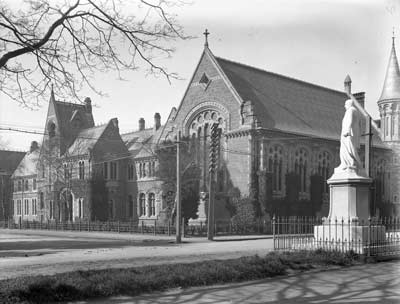Of all the buildings on the town site, the Great Hall is probably the most striking example of Gothic Revival. From the finials, tower, and steeply sloped roof, to the segmental arched windows and the decorative additions that incorporate practical necessities, the Hall formed an impressive cornerstone for Canterbury College. Designed by Benjamin Mountfort at a cost of £6,290, the building imitates nearby Canterbury Museum, with circular lights in the windows reflecting those in the Museum’s rose window. Once again however, due to finances the end result was a scaled down version of Mountfort’s original design, which had been meant to include not one but three towers.

The Great Hall

The Great Hall, with the memorial window and distinctive tower, is seen here from the corner of Rolleston Avenue and Worcester Boulevard.
When the Great Hall opened in 1882, it was intended for use both as a space for lectures, and for holding examinations or ceremonies. It would have seemed fitting then that the opening celebration for the Hall in August that year was the graduation ceremony, at which some well-known Cantabrians had degrees conferred upon them. Amongst them were Kate Edger, Charles Chilton and James Hay.
The interior of the Hall was obviously well appointed for such occasions. The building included a dais on which appropriate luminaries could sit, with a gallery above, capped off by a vaulted ceiling comprised of native timbers. The Chancellor of the University of New Zealand, speaking at the ceremony, offered his praise. “Not only the College, but also those who share with it the desire to encourage and exalt learning, and to establish it on a wide and solid foundation, are to be congratulated on the completion of so handsome a hall.” The Chancellor’s speech was followed by Professor Macmillan Brown, who spoke on the true value of education, and advised students to “Be wise in the selection of your aims as well as in that of your means. Never shoot flies with forty-pounders.”
While it may have been intended for grand occasions, the Hall was inevitably put to other uses. In its early years the Hall housed the College’s small library, was a temporary home to Professor Scott’s engineering apparatus, and the rooms behind the dais later became the quarters to the music department. Alongside these day to day functions, the Hall was also to serve another function as a place of remembrance. Built in to the design for the Hall was the capacity to include memorial plaques and busts, with the intention that the College could record the achievements of its graduates for all to see. Amongst those remembered for their triumphs in the Hall are teachers Charles Cook and Alexander Bickerton, and students Helen Connon, Thomas Foster, and of course, Ernest Rutherford. It seems fitting that the inscription on Rutherford’s memorial reads ‘Exegi monumentum aere perennius’ or 'I have erected a monument more lasting than bronze'.